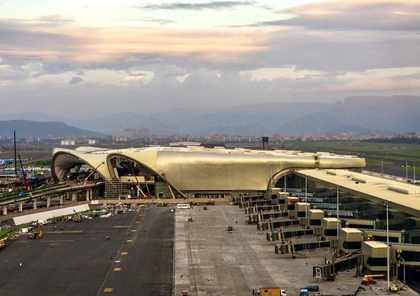Govt plans to nearly double number of airports to 350 in India’s Aviation Vision 2047
By IANS | Updated: October 23, 2025 18:40 IST2025-10-23T18:37:04+5:302025-10-23T18:40:17+5:30
New Delhi, Oct 23 India’s civil aviation sector has emerged as one of the fastest-growing sectors, making the ...

Govt plans to nearly double number of airports to 350 in India’s Aviation Vision 2047
New Delhi, Oct 23 India’s civil aviation sector has emerged as one of the fastest-growing sectors, making the country the third-largest domestic aviation market in the world.
The number of airports in the country has increased from 74 in 2014 to 163 in 2025.
As India moves toward its centenary year of independence, the government is charting an ambitious growth path for the aviation sector, which targets expanding the number of airports in the country from 163 in 2025 to over 350 by 2047, and passenger traffic is expected to cross one billion, according to an official statement issued on Thursday.
With 25 million jobs projected by 2047 and expanding opportunities in MRO, drone manufacturing, and pilot training, aviation will become a vital pillar of India’s $10 trillion economy, the statement said.
The UDAN (Ude Desh ka Aam Nagrik) scheme, launched in October 2016, has now completed nine years of a success story that has revolutionised regional connectivity with 3.23 lakh flights carrying 1.56 crore passengers to smaller airports.
UDAN has operationalised 649 routes and connected 93 aerodromes (including 2 water aerodromes and 15 heliports) across the country, among which 12 airports/heliports are in the North-East region. It has also integrated the Andaman, Nicobar, and Lakshadweep Islands into the national aviation network.
According to the International Civil Aviation Organisation (ICAO), investments in aviation have a strong ripple effect on the economy. For every rupee spent, the sector generates more than three times that value in economic activity and supports over six times as many jobs in connected industries.
Today, the sector supports over 7.7 million jobs indirectly, including 369,000 jobs directly. The demand for skilled personnel—pilots, engineers, ground staff, and logistics professionals—is expected to rise sharply.
With over 116 bilateral Air Service Agreements, India is deepening global connectivity as Indian carriers expand internationally, reinforcing the country’s position as an aviation hub in Asia. Civil aviation is also driving FDI inflows, technology transfer, and Make in India initiatives in aircraft manufacturing, ground handling, and Maintenance, Repair, and Operations (MRO) services.
Over the past decade, domestic air passenger traffic has grown 10-12 per cent annually.
India’s commercial airline fleet is predicted to grow from 400 aircraft in 2014 to around 2,359 aircraft in March 2040. The total employment due to the aviation sector in 2040 is expected to be around 25 million, emerging as a core engine of India’s journey towards becoming a developed economy.
According to NITI Aayog, domestic travellers accounted for over 83 per cent of total tourism spending in 2019, a figure expected to rise to nearly 89 per cent by 2028. This shift shows how government initiatives like UDAN have bridged the infrastructure gap and made air travel accessible for millions, connecting remote regions and making air travel affordable and accessible.
This reflects the government’s efforts to make air travel affordable and inclusive, supported by initiatives like UDAN. This transformation has also reshaped India’s travel map. Once remote destinations— Kullu, Darbhanga, Hubballi and Shillong—are now directly connected by air, boosting local economies and regional tourism, the statement added.
--IANS
sps/dan
Disclaimer: This post has been auto-published from an agency feed without any modifications to the text and has not been reviewed by an editor
Open in app